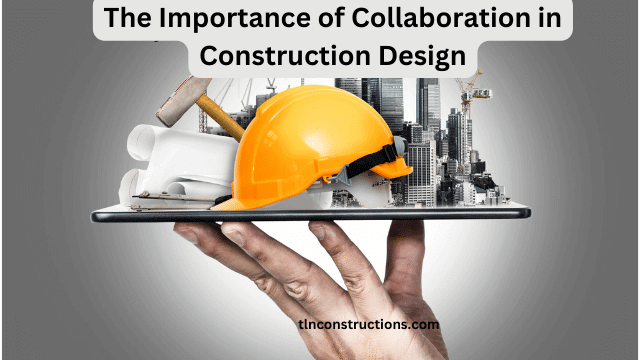Collaboration is an essential aspect of construction design that involves various parties working together to achieve a common goal. The construction industry is highly complex, and collaboration between architects, engineers, contractors, and clients is crucial to ensure the success of a project. The importance of collaboration in construction design cannot be overstated, as it leads to better design outcomes, increased efficiency, and improved communication. In this article, we will explore the various benefits of collaboration in construction design and how it can lead to successful project outcomes.
Benefits of Collaboration in Construction Design
Improved Design Outcomes
Collaboration between architects, engineers, and contractors leads to better design outcomes by incorporating a range of perspectives and expertise. Each team member brings unique skills and experience that contributes to the design process. By working together, they can identify potential issues and find innovative solutions. Collaboration also ensures that the design meets the client’s needs and expectations, resulting in a successful project outcome.
Enhanced Efficiency and Cost Savings
Collaboration in construction design can also lead to increased efficiency and cost savings. By working together, teams can identify areas where costs can be reduced, such as material selection, construction methods, and project scheduling. Collaboration also helps to streamline the construction process, reducing the time and resources required to complete the project.
Improved Communication
Effective communication is critical in construction design, and collaboration helps to ensure that all parties are on the same page. By establishing clear communication channels, teams can share ideas and information, identify potential issues, and find solutions. Collaboration also helps to reduce misunderstandings and errors, leading to a more successful project outcome.
Increased Innovation and Creativity
Collaboration in construction design can also lead to increased innovation and creativity. By working together, teams can identify new and innovative solutions to design challenges, incorporating the latest technologies and materials. Collaboration also encourages the sharing of ideas and knowledge, leading to a more creative and dynamic design process.
Reduced Risk and Improved Safety
Collaboration in construction design can help to reduce risk and improve safety. By working together, teams can identify potential hazards and develop strategies to mitigate them. Collaboration also ensures that all parties are aware of safety protocols and regulations, reducing the risk of accidents and injuries on the job site.
Best Practices for Collaboration in Construction Design
Effective collaboration requires careful planning and management. Here are some best practices for collaboration in construction design:
Establishing Clear Communication Channels
Clear communication channels are critical for effective collaboration. Teams should establish a communication plan that outlines how information will be shared, who is responsible for communication, and how often communication will occur. This plan should also identify any potential communication barriers and strategies for overcoming them.
Building Trust and Respect
Building trust and respect between team members is crucial for effective collaboration. Teams should foster an environment of mutual respect, where everyone’s contributions are valued and appreciated. Trust is built through open and honest communication, where team members feel comfortable sharing their thoughts and ideas without fear of judgment or reprisal.
Encouraging Open Dialogue and Sharing of Ideas
Open dialogue and the sharing of ideas is essential for effective collaboration. Teams should encourage everyone to contribute their thoughts and ideas, regardless of their role or position. This approach fosters a sense of ownership and investment in the project, leading to more innovative and creative solutions.
Using Collaborative Tools and Technologies
Collaborative tools and technologies, such as project management software, can help to streamline communication and collaboration. These tools allow team members to share information and updates in real-time, reducing the risk of miscommunication or delays. They can also provide a centralized platform for managing project documents and resources.
Emphasizing Teamwork and a Shared Vision
Emphasizing teamwork and a shared vision is essential for effective collaboration. Teams should work together towards a common goal, with a shared understanding of what success looks like. This approach fosters a sense of camaraderie and collaboration, where everyone is invested in the project’s success.
Challenges to Collaboration in Construction Design
Despite its many benefits, collaboration in construction design can also present challenges. Some common challenges include:
Communication Barriers
Communication barriers, such as language differences or technical jargon, can impede effective collaboration. Teams should establish clear communication channels and be mindful of potential communication barriers, such as different languages or cultural backgrounds.
Lack of Trust and Respect
A lack of trust and respect between team members can also hinder effective collaboration. Teams should work to build trust and respect, fostering an environment of open and honest communication.
Resistance to Change
Resistance to change can also present a challenge to effective collaboration. Teams should be willing to embrace new ideas and approaches, even if they are different from what they are used to.
Competing Interests and Priorities
Competing interests and priorities can also hinder effective collaboration. Teams should work together to identify shared goals and priorities, and find ways to align their interests towards a common goal.
Cultural and Language Differences
Cultural and language differences can also present a challenge to effective collaboration. Teams should be mindful of these differences and work to build a shared understanding of each other’s perspectives and approaches.
Conclusion
Collaboration is essential in construction design, leading to better design outcomes, increased efficiency, and improved communication. Effective collaboration requires clear communication, trust and respect, open dialogue, and a shared vision. Despite its many benefits, collaboration can also present challenges, such as communication barriers, resistance to change, and competing interests. By understanding these challenges and implementing best practices for collaboration, teams can overcome these obstacles and achieve successful project outcomes.
